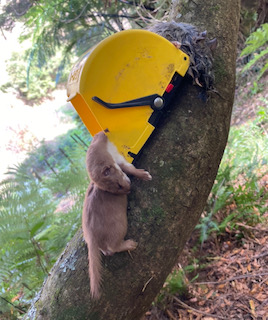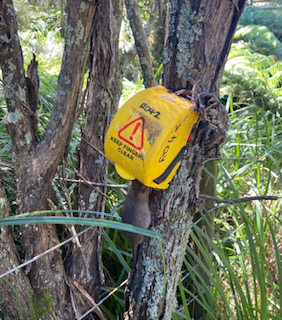Like I said, 1 month is a conservative estimate. If you had to leave home for a while and couldn’t check your traps, it’s the stuff to use, for sure. I’ve also had some luck with hickory BBQ sauce, too, because it has a lot of sugar and salt in it, which preserve it for quite a while. Rats are very fond of the chocolate and blood lures, but I’m sure you’d get a few with BBQ.
I’m still waiting for the himidity to decrease, because lures and bait can get moldy so damn quick. Goodnature lures will get moldy, but it takes way longer than food baits, because they have preservatives. If you have a few traps in damp, shady spots without much airflow, definitely use the Goodnature lure in them, instead of PB. Because you check your traps so often, PB’s fine to use in traps in sunnier spots that get a bit of airflow, but your kill totals with a Goodnature lure should not only be much higher, but will save you a lot of $ over time using them. I tried filling a big syringe with PB once to make it easier to use it, but it was a disaster. If the moldy PB you scrape off is in bits large enough to remove, I’d do that, because mold spreads way faster when there’s already mold inside the trap. 2 days of PB without mold goes to 1 day, in my experience. I’ve never tried this, but a light sprinkling of salt might reduce the time it takes to grow mold. I’ve just checks all of my traps, so could you give this a go? Rats are fond of salt, so you might end up with some fans of the combo.
A good bait to use in big traps are Erayz rabbit blocks, which are good to skewer. They go moldy in Winter, but they’re great the rest of the year. They’re a good Summer bait, because they stay good in traps for weeks and weeks, even when it’s hot. They only have a tiny amount of fat in them, so they don’t rot. Mustelids go nuts for rabbit, so it’s one of the best baits to use if they’re around.
In case you don’t know, if you put out fresh meat baits for mustelid species, remove them from your traps before they start to rot (usually 3 days), because that’s a big turn off to them, and dispose of the bait at home. I take a bag with a seal me to keep the smell locked away. If you have any DOC traps, use freshly-killed rats as bait - it can work wonders to trap more rats, and mustelids absolutely love to scavenge rats. The last stoat I trapped had a ship rat in it as bait. If you try this, rub the rat’s fur on the entrance to the trap as a scent lure, especially the hindquarters. You can rub it on the mesh, because bits of fur can get stuck. Like other meat baits, use them for 3 days, max. You can also rub rats on snap traps, because it makes rats think that it must be a safe area because others have visited it.
Geez, sorry for writing you a book! I can’t wait to find out if any of this helps. The advice I’ve taken from other trappers certainly has.
Mark




